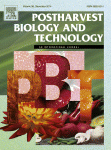Ver ítem
- xmlui.general.dspace_homeCentros e Institutos de InvestigaciónCIA. Centro de Investigaciones de AgroindustriaInstituto de Tecnología de AlimentosArtículos científicosxmlui.ArtifactBrowser.ItemViewer.trail
- Inicio
- Centros e Institutos de Investigación
- CIA. Centro de Investigaciones de Agroindustria
- Instituto de Tecnología de Alimentos
- Artículos científicos
- Ver ítem
Effect of commercial conditioning and cold quarantine storage treatments on fruit quality of ‘Rouge La Toma’ grapefruit (Citrus paradisi Macf.)
Resumen
We evaluated the effect of cold quarantine treatments on the development of CI and temperature conditioning on the induction
of low temperature tolerance in “Rouge La Toma” grapefruit (Citrus paradisi Macf.), and their effects on acetaldehyde, ethanol
and d-limonene contents and sensory characteristics. Various treatments, non-conditioned + quarantine at 2 ◦C and 85% RH for
18 days + storage at 13 ◦C and 85% RH for 4 days or 17 days + marketing period
[ver mas...]
We evaluated the effect of cold quarantine treatments on the development of CI and temperature conditioning on the induction
of low temperature tolerance in “Rouge La Toma” grapefruit (Citrus paradisi Macf.), and their effects on acetaldehyde, ethanol
and d-limonene contents and sensory characteristics. Various treatments, non-conditioned + quarantine at 2 ◦C and 85% RH for
18 days + storage at 13 ◦C and 85% RH for 4 days or 17 days + marketing period at 20 ◦C and 85% RH for 7 days; conditioned
at 15 ◦C and 85% RH for 7 days + quarantine at 2 ◦C and 85% RH for 18 days + storage at 13 ◦C and 85% RH for 4 days or
17 days + marketing period at 20 ◦C and 85% RH for 7 days; storage at 13 ◦C and 85% HR for 22 days or 35 days + marketing
period at 20 ◦C and 85% RH for 7 days (control treatments), were assayed. By the end of the simulated marketing period,
the conditions did not promote chilling injury development in “Rouge La Toma” grapefruit. After the simulated marketing
period, acetaldehyde, ethanol and d-limonene contents were not affected in fruit stored under treatments that included cold
quarantine. In some cases, treatments that included temperature conditioning significantly increased acetaldehyde and ethanol
levels, however, the amounts detected were comparable with fresh grapefruit juice. In general, the storage times involved in the
treatments assayed, did not promote increases in the acetaldehyde and ethanol levels. Conversely, fruit stored at non-chilling
temperatures (control treatments) had higher levels of d-limonene compared to those which underwent treatments that included
cold quarantine. In addition, a significant increase in d-limonene levels between the initial time of the treatments and the end of the
marketing periodwas observed, for all treatments, with the highest and most variables levels observed in fruit stored under control
treatments. Sensory characteristics, such as sweet, acid and bitter taste and typical flavor intensity, in general, were not affected
by the postharvest handling practices applied. Therefore, it can be concluded that the cold quarantine treatment and temperature
[Cerrar]

Fuente
Postharvest biology and technology 35 (2) : 167-176 (February 2005)
Fecha
2004-08-23
ISSN
0925-5214
Formato
pdf
Tipo de documento
artículo
Palabras Claves
Derechos de acceso
Restringido
 Excepto donde se diga explicitamente, este item se publica bajo la siguiente descripción: Creative Commons Attribution-NonCommercial-ShareAlike 2.5 Unported (CC BY-NC-SA 2.5)
Excepto donde se diga explicitamente, este item se publica bajo la siguiente descripción: Creative Commons Attribution-NonCommercial-ShareAlike 2.5 Unported (CC BY-NC-SA 2.5)

